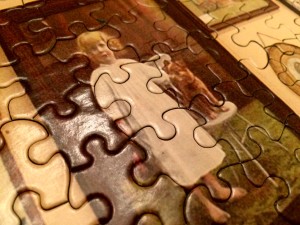 Have you ever been in a mess that you thought you’d never find your way out of?
Have you ever been in a mess that you thought you’d never find your way out of?
Perhaps we can find some wisdom on how to endure the doubt by turning to an often forgotten pastime, the puzzle.
I received my first puzzle as an adult from my wife this Valentine’s Day. Nothing says “I love you” like 1,000 frustrations scattered across your dining room table. We began by sorting the pieces. First, find the edges. All of them. (Pro puzzler tip: Don’t have your children sort the pieces. They forget what pieces they’re looking for and just toss them in piles which you have to comb through again.) While you’re seeking out the edges, why not sort the rest by color? Start with light and dark. Now you have two piles plus the edges. Once you get the perimeter in place all you have to do is put together the remaining 902 pieces. I thought this would be a good system until I realized there are a lot of light and dark pieces. Even when separated it didn’t provide much relief. I still didn’t know where to begin.
The first several sittings were pretty wimpy. In order to keep spirits high we initiated a sound effect when we placed a piece.
“Haayyyoooooohhh!!!”
We didn’t say it much at first but when we did it felt great. The kids picked it up pretty quickly. Mostly their sirens were false alarms.
The puzzle joined us for a dinner party one night. We had a couple we love over and we had to shift to one end of the table to accommodate our malnourished table guest. We learned that this couple, too, loves puzzling. Of course they do. They shared their experiences and made us comrades. They discussed long hours staring down in agony unable to turn away. I remarked that this must be the days-passed equivalent of blowing an entire weekend watching every episode of a series on Netflix. Meredith dubbed this “the puzzle time warp.”
Days passed in which we passed the puzzle without as much as a casual caress. These are commonly known as weekdays. Who has time for a puzzle when you’re flopping around like a bottle rocket tied to a rubber band? But when the weekend came, when we weren’t flopping around like a bottle rocket tied to a rubber band, we puzzled. Each sitting ending with fewer pieces scattered about all willy-nilly. The sense of accomplishment was starting to release into the air. Then, one day, we had a breakthrough session. We decided to abandon, momentarily, the sections we had been grappling with to piece together a new section. This was a turning point. The success achieved on this front proved to us that this puzzle could be solved and that we had every business being the solvers. From there, it was pretty much a bloodbath.
With every piece placed, the pace quickened. The flywheel was engaged. Momentum was on our side. As we neared the point of surrender, something became clear to me other than the picture on the puzzle.
The process of conquering a puzzle is a lot like conquering the problems that plague us when we’re not puzzling. I’m not talking about the obvious parallel of having to solve a problem like you solve a puzzle. I want to understand the way you feel during the process. There are moments, especially in the beginning where you just have a bunch of pieces dumped in a big pile. You try to sort through them but all you end up with is more piles. Sure, you can find the edges pretty easily but then it gets tough, quickly. The effort is high but the rewards are sparse. You get an occasional glimpse of something, you go to put it in place to learn that it doesn’t fit there. This happens often. Eventually, your eyes go wonky and you have to get up and walk away discouraged. You feel a little defeated. You sat down, gave it your best and accomplished very little.
What you don’t realize early is that you are setting the stage even if you aren’t setting many pieces yet. You’re taking in the problem. You’re sorting your resources. You’re experimenting and taking mental notes. You’re beginning to recognize the pieces of the pattern. In a puzzle you have the luxury of seeing the picture you’ll end with. The pattern is made known to you in advance. (It’s still super frustrating.) In your problem, you have to have faith that there is a pattern and that all these pieces strewn in front of you actually do go together. You have to convince yourself that, like the puzzle, your problem can be solved and that you have every business being the solver. You need to keep that faith when your eyes go wonky and you storm out of the room feeling defeated. You must believe that eventually you’ll stop trying to connect pieces that don’t belong together. One day, the flywheel will kick in and momentum will be on your side. What started as flailing will end in fluid precision as you direct each and every piece in obedience to its permanent place.
Until then…
Keep coming back to the table.
Keep picking up the pieces.
There’s a bigger picture waiting for you.
Don’t you want to see it?


